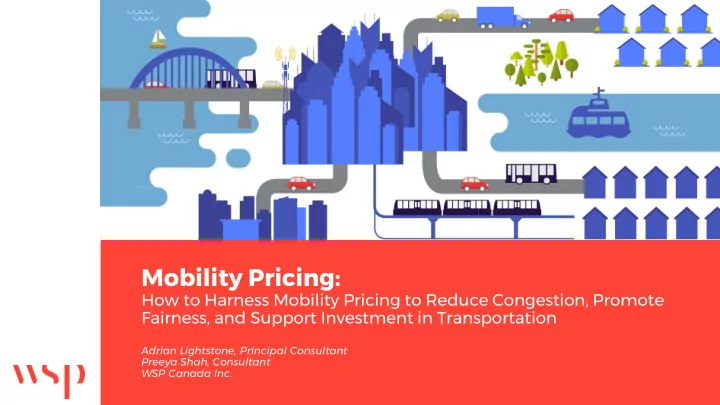

Mobility Pricing: How to Harness Mobility Pricing to Reduce Congestion, Promote Fairness, and Support Investment in Transportation Adrian Lightstone, Principal Consultant Preeya Shah, Consultant WSP Canada Inc.
What? • 23 municipalities in Metro Vancouver, British Columbia • Independent Commission established to evaluate regional mobility pricing • Final Commission report published on May 24, 2018
• Metro Vancouver Why? population is growing rapidly • Traffic congestion is threatening growth and productivity • Traffic hot spots are occurring throughout the region • Technological change is occurring
How does mobility Why not solve congestion by adding capacity? pricing work? “Congestion? Build more roads!” — Costs for new road infrastructure capacity increases non- linearly in high-density areas 5 — Growing cities need to accommodate for travel growth, but cars are not the most efficient mechanism — Induced demand means we can’t build our way out!
How does mobility We cannot make capacity match demand… pricing work? … so let’s make demand match capacity through efficient pricing 10 minutes 6 Travel time: 16 minutes 46 minutes All vehicles are charged in de-congestion charging, but the objective is that the only the last 3 (green) cars choose not to drive.
Economic theory How do you incentivize people out of their cars? 7
Economic theory Marginal social cost pricing - Drivers only consider their Marginal Private Cost – fuel, vehicle operating, insurance, travel time - Marginal Social Cost accounts for the burden each driver imposes on society in terms of 8 congestion delay and other externalities - A socially optimal Congestion Charge is priced as the difference between the Marginal Private Cost and Marginal Social Cost
Design options
Design options System of point charges used to approximate Marginal Social Cost pricing 11 Distance-based charges used to approximate Marginal Social Cost pricing
Design options System of point charges used to approximate Marginal 12 Social Cost pricing
Analysis of options 13
Equity and fairness Equity and fairness concepts Equity: How evenly are costs and/or benefits distributed? Vertical equity: Distribution between various income groups 14 Horizontal equity: Distribution in other dimensions: gender, geography, modes of transport Fairness: Perceptions of fairness are individual, and not everyone agrees on which properties of a policy make it fair (or unfair)…but transfers can help make things fairer
Analysis of options Congestion Revenue 16 Fairness
Acceptance issues Public acceptance Metro Vancouver is on this part of the curve 18
Acceptance Does it work? issues 19
Final What did we learn? Singapore thoughts ERP — Every city is different and there is no one-size fits all solution Central London Congestion — Detailed analysis can be done Charge quickly with some basic tools and iterative process 20 — It’s not possible to maximize all Stockholm design objectives Congestion Tax — However, it’s possible to develop solutions which generate large net economic benefits and can be used to correct equity imbalances Gothenburg Congestion Tax
Thank you! wsp.com
Cases Location Singapore Policy Congestion Charge Singapore Pricing framework Point charges, varied by time of day ERP and location Technology RFID Implementation year 1998 Traffic volume -44% after ALS, -10% to -15% after ERP Effect on traffic & compared to ALS, -20% to -30% for other environment extensions of the system Travel times Speed criteria charge levels between 20-30 kph and 45-65 kph Environment n.a. 250 million CAD (including 68,000 tags) Investment Economic impact cost 16 million CAD/year (20%-30% of revenues) Operating cost Revenue 200 million CAD/year CBA 63 million CAD/ year
Cases Location London, United Kingdom Policy Congestion Charge Central Pricing framework Point charges with variable pricing London Technology ANPR Congestion Implementation year 2003 Charge Traffic volume -16% (all vehicles entering the zone), -30% chargeable vehicles, +25% busses, +13% taxis, Effect on traffic & +49% bicycle environment -21% (2002-2008) Travel times - 30 % delays Environment CO 2 -16,4%, NO x -13,4 %, PM10 -15.5% within the zone 300 million CAD Investment Economic impact cost 170 million CAD/year, in recent years 85 million Operating cost CAD/year Revenue 440 million CAD/year (in 2014) CBA 140-190 million CAD/year
Cases Location Stockholm, Sweden Policy Congestion Charge Stockholm Pricing framework Point charges with variable pricing Congestion Technology ANPR tax Implementation year 2007 (following a trial) environment Traffic volume -20% (across the cordon) Effect on traffic & Travel times -33 % delays Environment CO2 -13%, NOx -8 %, PM10 -13% within the zone 270 million CAD Investment Economic impact cost 25 million CAD/year (in 2016) Operating cost Revenue 150 million CAD/year (in 2016) CBA 100 million CAD/year
Recommend
More recommend